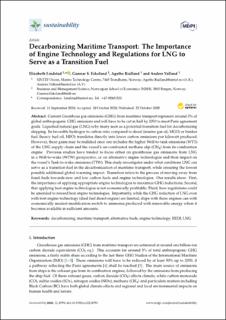| dc.contributor.author | Lindstad, Elizabeth | |
| dc.contributor.author | Eskeland, Gunnar | |
| dc.contributor.author | Rialland, Agathe Isabelle | |
| dc.contributor.author | Valland, Anders | |
| dc.date.accessioned | 2020-10-26T09:35:14Z | |
| dc.date.available | 2020-10-26T09:35:14Z | |
| dc.date.created | 2020-10-24T11:59:41Z | |
| dc.date.issued | 2020 | |
| dc.identifier.citation | Sustainability. 2020, 12 (8793), . | en_US |
| dc.identifier.issn | 2071-1050 | |
| dc.identifier.uri | https://hdl.handle.net/11250/2684921 | |
| dc.description.abstract | Current Greenhous gas emissions (GHG) from maritime transport represent around 3% of global anthropogenic GHG emissions and will have to be cut in half by 2050 to meet Paris agreement goals. Liquefied natural gas (LNG) is by many seen as a potential transition fuel for decarbonizing shipping. Its favorable hydrogen to carbon ratio compared to diesel (marine gas oil, MGO) or bunker fuel (heavy fuel oil, HFO) translates directly into lower carbon emissions per kilowatt produced. However, these gains may be nullified once one includes the higher Well-to-tank emissions (WTT) of the LNG supply chain and the vessel’s un-combusted methane slip (CH4) from its combustion engine. Previous studies have tended to focus either on greenhouse gas emissions from LNG in a Well-to-wake (WTW) perspective, or on alternative engine technologies and their impact on the vessel’s Tank-to-wake emissions (TTW). This study investigates under what conditions LNG can serve as a transition fuel in the decarbonization of maritime transport, while ensuring the lowest possible additional global warming impact. Transition refers to the process of moving away from fossil fuels towards new and low carbon fuels and engine technologies. Our results show: First, the importance of applying appropriate engine technologies to maximize GHG reductions; Second, that applying best engine technologies is not economically profitable; Third, how regulations could be amended to reward best engine technologies. Importantly, while the GHG reduction of LNG even with best engine technology (dual fuel diesel engine) are limited, ships with these engines can with economically modest modification switch to ammonia produced with renewable energy when it becomes available in sufficient amounts. | en_US |
| dc.description.sponsorship | This study has been financially supported by the Norwegian Research Council project (Norges Forskningsråd) SFI Smart Maritime project number 237917. | en_US |
| dc.language.iso | eng | en_US |
| dc.subject | decarbonizing | en_US |
| dc.subject | maritime transport | en_US |
| dc.subject | alternative fuels | en_US |
| dc.subject | engine technology | en_US |
| dc.subject | EEDI | en_US |
| dc.subject | LNG | en_US |
| dc.title | Decarbonizing Maritime Transport: The Importance of Engine Technology and Regulations for LNG to serve as a Transition Fuel | en_US |
| dc.type | Journal article | en_US |
| dc.type | Peer reviewed | en_US |
| dc.description.version | publishedVersion | en_US |
| dc.rights.holder | © 2020 by the authors. Licensee MDPI, Basel, Switzerland. This article is an open access article distributed under the terms and conditions of the Creative Commons Attribution (CC BY) license (http://creativecommons.org/licenses/by/4.0/). | en_US |
| dc.source.pagenumber | 21 | en_US |
| dc.source.volume | 12 | en_US |
| dc.source.journal | Sustainability | en_US |
| dc.source.issue | 8793 | en_US |
| dc.identifier.doi | 10.3390/su12218793 | |
| dc.identifier.cristin | 1841921 | |
| cristin.ispublished | true | |
| cristin.fulltext | original | |
| cristin.qualitycode | 1 | |
